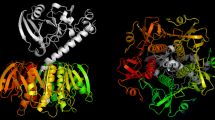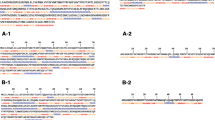Abstract
Enterohemorrhagic (EHEC) and enteroaggregative (EAEC) are two pathotypes of diarrheagenic Escherichia coli. EAEC strains express adhesins called aggregate adherence fimbriae (AAFs) which the bacteria use to adhere to intestinal mucosa. EHEC virulence factor is Shiga toxin which belongs to the AB5 toxin family. B subunit, the nontoxic part of Shiga toxin (StxB), forms a homo pentamer and is responsible for binding to target cells. StxB has recently been proven to have adjuvant activity. In the current study we fused StxB encoding gene to 3' end of genes encoding two variants of AAFs, i.e., AAF/I and AAF/II. The in silico studies on tertiary structure and biochemical characteristics of Shiga toxin A subunit (StxA) revealed more resemblance to AAF/II than AAF/I. The constructs were prepared in a way that StxB could imitate its natural structure (pentamer formation) and its position (C-terminus) in the native toxin complex. The expression of these constructs showed the formation of AAF/II-B as a protein complex but with lower molecular mass than its expected size. In contrast, the AAF/I-B complex was not formed. Overall, the results of in silico studies and expression experiments together revealed that despite AAF/II-B expression, StxB failed to form pentamer. Therefore the observed protein complex has lower molecular mass. Since StxB is bound to AAF/II through disulfide bond, this bond prevents pentamer formation of StxB. However, due to the lack of disulfide bond between AAF/I and StxB, no protein complex is formed, thus StxB maintains its pentamer structure.









Similar content being viewed by others
References
Flores J, Okhuysen PC (2008) Enteroaggregative Escherichia coli infection. Curr Opin Gastroenterol 25:8–11
Rúgeles LC, Bai J, Martínezetal AJ, Vanegas MC, Gómez-Duarte OG (2010) Molecular characterization of diarrheagenic Escherichia coli strains from stools samples and food products in Colombia. Int J Food Microbiol 138:282–286
Croxen MA, Finlay BB (2010) Molecular mechanisms of Escherichia coli pathogenicity. Nat Rev Microbiol 8:26–38
Harrington SM, Dudley EG, Nataro JP (2006) PathogenesisofenteroaggregativeEscherichia coliinfection. FEMS Microbiol Lett 254:12–18
Boisen N, Struve C, Scheutz F, Krogfelt KA, Nataro JP (2008) New adhesin of enteroaggregative Escherichia coli related to the Afa/Dr/AAF family. Infect Immun 76:3281–3292
Elias WP Jr, Czeczulin JR, Henderson IR, Trabulsi LR, Nataro JP (1999) Organization of biogenesis genes for aggregative adherence fimbria II defines a virulence gene cluster in enteroaggregative Escherichia coli. J Bacteriol 181:1779–1785
Bouzari S, Dashti A, Jafari A, Oloomi M (2010) Immune response against adhesins of enteroaggregative Escherichia coli immunized by three different vaccination strategies (DNA/DNA, protein/protein, and DNA/protein) in mice. Comput Immunol Microbiol Infect Dis 33:215–225
Johannes L, Romer W (2010) Shiga toxins–from cell biology to biomedical applications. Nat Rev Microbiol 8:105–116
Jemal C, Haddad JE, Begum D, Jackson MP (1995) Analysis of Shiga toxin subunit association by using hybrid A polypeptides and site-specific mutagenesis. J Bacteriol 177:3128–3132
Fraser ME, Fujinaga M, Cherney MM, Melton-Celsa AR, Twiddy EM, O'Brien AD, James MN (2004) Structure of Shiga toxin type 2 (Stx2) from Escherichia coli O157:H7. J Biol Chem 279:27511–27517
Iwasa M, Makino S, Asakura H, Kobori H, Morimoto Y (1999) Detection of Escherichia coli O157:H7 from Musca domestica (Diptera: Muscidae) at a cattle farm in Japan. J Med Entomol 36:108–112
Ohmura M, Yamamoto M, Tomiyama-Miyaji C, Yuki Y, Takeda Y, Kiyono H (2005) Nontoxic Shiga toxin derivatives from Escherichia coli possess adjuvant activity for the augmentation of antigen-specific immune responses via dendritic cell activation. Infect Immun 73:4088–4097
Gao X, Cai K, Shi J, Liu H, Hou X, Tu W, Xiao L, Wang Q, Wang H (2009) Immunogenicity of a novel Stx2B-Stx1B fusion protein in a mice model of Enterohemorrhagic Escherichia coli O157:H7 infection. Vaccine 27:2070–2076
Adotevi O, Vingert B, Freyburger L, Shrikant P, Lone YC, Quintin-Colonna F, Haicheur N, Amessou M, Herbelin A, Langlade-Demoyen P, Fridman WH, Lemonnier F, Johannes L, Tartour E (2007) B subunit of Shiga toxin-based vaccines synergize with alpha-galactosylceramide to break tolerance against self antigen and elicit antiviral immunity. J Immunol 179:3371–3379
http://www.ncbi.nlm.nih.gov/gene . Accessed 14 March 2011
http://www.pdb.org. Accessed 12 April 2011
http://robetta.org. Accessed 8 June 2011
http://zhanglab.ccmb.med.umich.edu/QUARK. Accessed 13 June 2011
http://topmatch.services.came.sbg.ac.at. Accessed 14 June 2011
http://web.expasy.org/protscale. Accessed 21 April 2011
Jayaram B, Bhushan K, Shenoy SR, Narang P, Bose S, Agrawal P, Sahu D, Pandey V (2006) Bhageerath: an energy based web enabled computer software suite for limiting the search space of tertiary structures of small globular proteins. NucleicAcids Res 34:6195–6204
Bonneau R, Baker D (2001) Ab initio protein structure prediction: progress and prospects. Annu Rev Biophys Biomol Struct 30:173–189
Sippl MJ, Wiederstein M (2008) Anoteondifficultstructurealignmentproblems. Bioinformatics 24:426–427
Sippl MJ (2008) Ondistanceandsimilarityinfoldspace. Bioinforma 24:872–873
Ikai A (1980) Thermostability and aliphatic index of globular proteins. J Biochem 88:1895–1898
Kyte J, Doolittle RF (1982) A simple method for displaying the hydropathic character of a protein. J Mol Biol 157:105–132
Oloomi M, Bouzari S, Emami S (2009) A recombinant hybrid peptide composed of AAF adhesin of enteroaggregative Escherichia coli and Shiga toxin B subunit elicits protective immune response in mice. Eur J Clin Microbiol Infect Dis 28:1311–1316
Conrady DG, Flagler MJ, Friedmann DR, Vander Wielen BD, Kovall RA, Weiss AA, Herr AB (2010) Molecular basis of differential B-pentamer stability of Shiga toxins1 and 2. PLoS One 5:e15153
Baibakov B, Murtazina R, Elowsky C, Giardiello FM, Kovbasnjuk O (2010) Shiga toxin is transported into the nucleoli of intestinal epithelial cells via a carrier-dependent process. Toxins 2:1318–1335
Acknowledgments
This project was financially supported by Pasteur Institute of Iran. We gratefully acknowledge the help of Dr. A. Jahanian-Najafabadi in preparation of the manuscript.
Author information
Authors and Affiliations
Corresponding authors
Rights and permissions
About this article
Cite this article
Noroozian, Z., Oloomi, M. & Bouzari, S. Analyzing of expression of novel polypeptide complexes consisting of Shiga toxin B subunit and Adherence Fimbriae of Escherichia coli based on in silico modeling. J Mol Model 18, 4131–4139 (2012). https://doi.org/10.1007/s00894-012-1414-3
Received:
Accepted:
Published:
Issue Date:
DOI: https://doi.org/10.1007/s00894-012-1414-3




